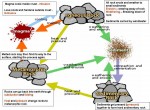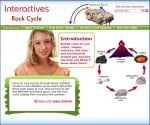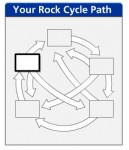 Announcement:
Announcement:
National Park Projects Due Tuesday Jan 17
Interactive Rock Cycle Assignment Due Monday Jan 23
Geology Unit Exam – Thursday Jan 26
AFTER SCHOOL REVIEW: Tuesday Jan 24
Study Guide in Classroom Notes Link —>
Remember for the Projects –
You Are Telling a Story, Not Just the Facts!
Show What You Know!
FOR YOUR PARK PROJECTS
In class we will watch the following video on Weathering and Erosion, with a Worksheet.
NATIONAL GEOGRAPHIC: AMAZING PLANET – DESTRUCTIVE FORCES
Weathering and erosion shape the world that is around us. Watch and listen as Zoe and RJ from the StudyJams Crew explain the science behind weathering and erosion.
Now go to the link Weathering and Erosion to complete the handout given in class…
Weathering and Erosion
If you complete this, check out
All rock started as magma. The rock cycle started with the cooling of the earth’s magma billions of years ago. But after that, it has no end. Rather, it is an ongoing cycle in which rock — driven by tectonic processes such as volcanoes and earthquakes, the surface processes of weathering and erosion, and compaction — is created and destroyed.
For this assignment, you will go to the following web site:
Directions for the Assignment:
- Open the Interactives Rock Cycle in a different window.
This interactive web site will help you to review the types of rocks and the processes that occur within the rock cycle. Instructions given on the web site will lead you through the different sections of material.
- To begin, click on the link entitled: “Begin with Types of Rocks.”
The tutorial will review the three rock families and provide you with a list of key characteristics that can be used to place samples within the three rock families.
- When you have read through this section, click on the next link: “Start your rock collection.”
In this part of the tutorial, when you click on the rock sample, you will be provided with the name of the rock as well as information on how the rock forms and where it can be found. Make sure to add the rocks to your collection.
- The next section, “Identify Rock Types”, will allow you to test your ability to recognize rock characteristics and types. Note: this section is timed (six minutes…more than enough time to complete the activity).
- When you have completed this self-test, go on to the next section, which describes How Rocks Change. Be sure to view the animation sequences provided for each rock family!
- At the end of this section, complete the self-test Transform the Rock to see if you can identify the processes that can change rocks from type to another.
This self-test is timed (six minutes); to complete the sequence, click and drag your answer into the appropriate box.
- The next section describes the rock cycle and also includes a self-test Complete the Rock Cycle to see if you can name the different parts of the rock cycle.
- The final activity at the web site is a Test Your Skills assessment to see how much you have learned.
Enter your first and last name in the space provided. When you have completed the assessment, print out your results. Make sure that you print out the complete results. Do not just print your score. You must show your teacher the printout with all of the graded questions to get credit.
This will then become your Study Sheet!
Alternate Assignment: Rocky’s Journey
You are now a well-educated geologic student of The Rock Cycle!




